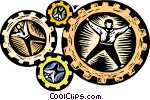In a recent Forbes article, HR Managers were advised to focus on “talent management.” Sounds reasonable given the information age, internet and the competitive need for creativity, but I find myself asking, “Who wants to be treated as talent to be managed?”
It reminds me of factory workers in the early 1900’s who were seen as extensions of the machine to be optimized.  Although the world has changed, articles like Forbe’s suggest we are still seeing employees as “cogs in the organizational machinery,” talented cogs to be sure, but cogs. And therein lies a problem.
Although the world has changed, articles like Forbe’s suggest we are still seeing employees as “cogs in the organizational machinery,” talented cogs to be sure, but cogs. And therein lies a problem.
As long as HR Managers (and senior Leaders) see people as company assets to be optimized, we’ll continue to create environments that kill the human spirit. Employees will remain disposable parts, abstract concepts to be planned for, controlled and manipulated. CEOs and organizational hierarchy will continue to see themselves separate from the “masses.”
But different models are emerging, each the result of the beliefs, personal passion. and unique circumstances of their creators. In each example people are, well people, not assets. 
Here are some of my favorite out-of-the-box examples: Ricardo Semler’s Maverick: The Success Story Behind the World’s Most Unusual Workplace, Tony Hsieh’s story of Zappo’s Delivering Happiness: A Path to Profits, Passion, and Purpose
, Phil Jackson and Hugh Delehanty’s Sacred Hoops: Spiritual Lessons of a Hardwood Warrior
, and Jack Stack’s The Great Game of Business, Expanded and Updated: The Only Sensible Way to Run a Company
.
Using the word “talent” when the writer really means “employee” adds an element of mystification, but of course the result is the same. Thanks for referring us to the more enlightened systems that are coming into play.
Yes, can we see employes as more than a bundle of skills to be managed. Maybe it’s also a challenge for us: do we see ourselves as more than our work, our skills…
Barb,
I could not agree with you more. Workers are assets for any organization. However, when we de-humanize them as business entities often do, it elucidates such age-old questions as to why employees become complacent, apathetic and eventually prone to abject underachievement.
If employees were treated like the assets that they are and provided the incentives and permission produce at their highest level for the good of the organization, our products and services would be unmatched in quality. Further, our organizations would be run considerably more efficiently.
To be fair, some organizations do make the effort to develop and encourage their employees to achieve at their highest level. Unfortunately, these few organizations are the exception.